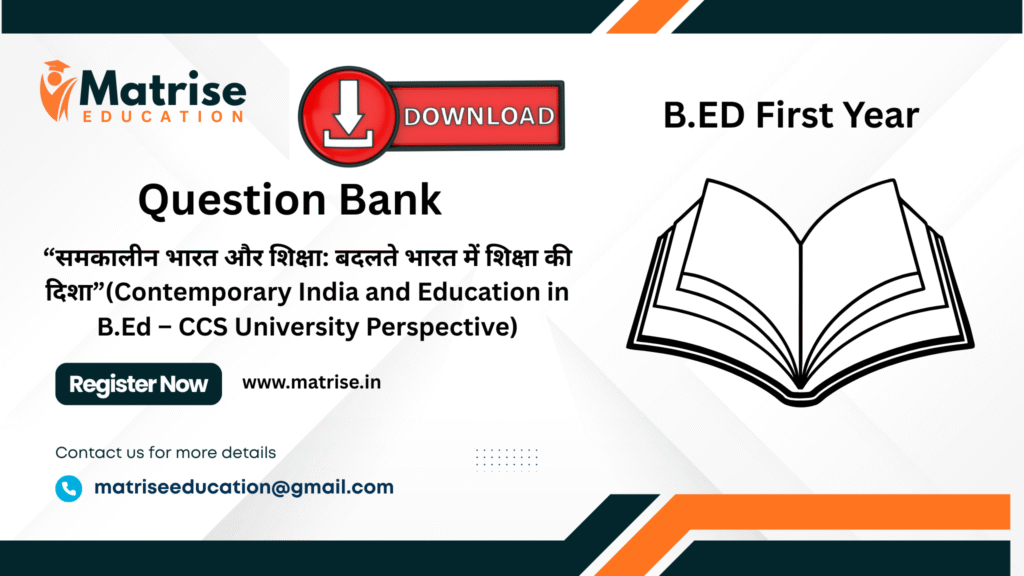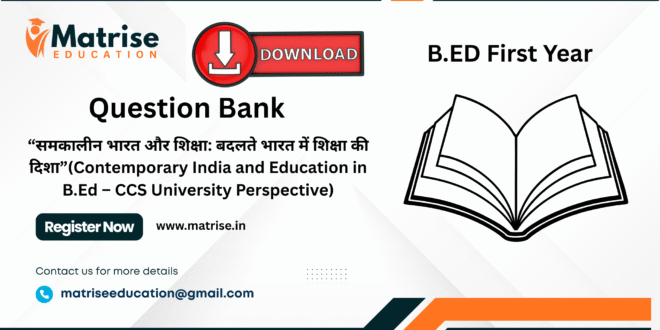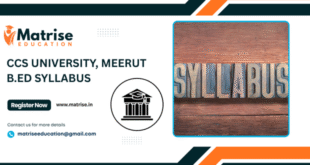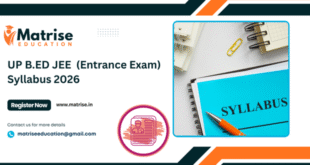🧠 Aim / Purpose
The aim of the course is to provide student-teachers with a conceptual understanding of education in the Indian context — focusing on issues of diversity, inequality, marginalization in Indian society and their implications for education.
✅ Course Code & Placement
- Download Question Bank of E-101 (Contemporary India and Education)
- Course Code: E-101 for CC1: Contemporary India and Education.
- It is a Core Course (CC) in Group A: Perspectives in Education in the first year.
- Max marks: 100 (External 80 + Internal 20) for Year I
📚 Content / Units
As per the syllabus (textbook listing) for CCSU the units include:
- Unit I: Education in India: Vedic period, Buddhist period, Medieval period.
- Unit II: Policy Framework of Education in Pre-Independent Period: e.g., Macaulay’s Minute (1835), Woods Despatch (1854), Hunter Commission (1882), Indianisation of Education, Lord Curzon Policy (1902), Gokhale Bill (1910), Sadler Commission (1917), Hartog Committee (1929), Basic Education (1937), Sargent Report (1944).
- Unit III: Policy Framework of Education in Post-Independent Period: e.g., University Education Commission (1948-49), Secondary Education Commission (1952-53), Indian Education Commission (1964-66), National Policy of Education 1986 and its review 1992, the National Curriculum Framework 2005 (NCF 2005)
- Unit IV: Elementary Education: Universalisation (provision, enrolment, retention, success), wastage & stagnation, Education for All (EFA) / Sarva Shiksha Abhiyan (SSA), Minimum Levels of Learning (MLL), review of Mid-Day Meal Programme, Kasturba Balika Vidyalaya Yojana, Right to Education (RTE) Act (2009) etc.
- Unit V: Secondary Education: Expansion, differentiation of curricula between boys & girls, discrimination in curricula, vocationalisation of education.
- Unit VI: Current Issues: e.g., University autonomy, privatisation of education, commercialization of education; education of marginalized groups (women, SC/ST, minorities, slum-areas), medium of instruction & Three Language Formula, population education.
1. प्रस्तावना (Introduction)
भारत जैसे विविधतापूर्ण देश में शिक्षा का महत्व अत्यधिक है। ‘समकालीन भारत और शिक्षा’ विषय इस बात पर केंद्रित है कि शिक्षा कैसे समाज, संस्कृति, राजनीति और अर्थव्यवस्था को प्रभावित करती है।
2. ऐतिहासिक परिप्रेक्ष्य (Historical Background)
- वैदिक, बौद्ध, इस्लामी एवं ब्रिटिश कालीन शिक्षा व्यवस्था
- भारत की शिक्षा पर मैकाले का प्रभाव
- स्वतंत्रता आंदोलन में शिक्षा की भूमिका
3. स्वतंत्र भारत में शिक्षा नीति (Post-Independence Education Policies)
- विश्वविद्यालय शिक्षा आयोग (1948-49)
- माध्यमिक शिक्षा आयोग (1952-53)
- कोठारी आयोग (1964-66)
- राष्ट्रीय शिक्षा नीति (1986, 1992, 2020)
4. वर्तमान भारत की शिक्षा प्रणाली (Contemporary Education System)
- शिक्षा का अधिकार अधिनियम (RTE, 2009)
- सर्व शिक्षा अभियान व राष्ट्रीय माध्यमिक शिक्षा अभियान
- नई शिक्षा नीति (NEP 2020) की प्रमुख विशेषताएँ
5. शिक्षा और सामाजिक न्याय (Education and Social Justice)
- शिक्षा में समान अवसर
- स्त्री शिक्षा, दलित एवं आदिवासी शिक्षा
- अल्पसंख्यक शिक्षा और समावेशी दृष्टिकोण
6. शिक्षा के समकालीन मुद्दे (Contemporary Challenges in Education)
- निजीकरण और व्यावसायीकरण
- रोजगार उन्मुख शिक्षा की आवश्यकता
- तकनीकी शिक्षा और डिजिटल डिवाइड
CLICK ON THE IMAGE TO DOWNLOAD THE QUESTION BANK.

 Matrise Education | India’s Trusted Education Consultancy for Admission & Career Guidance Empowering Students with Smarter Admission Guidance
Matrise Education | India’s Trusted Education Consultancy for Admission & Career Guidance Empowering Students with Smarter Admission Guidance





